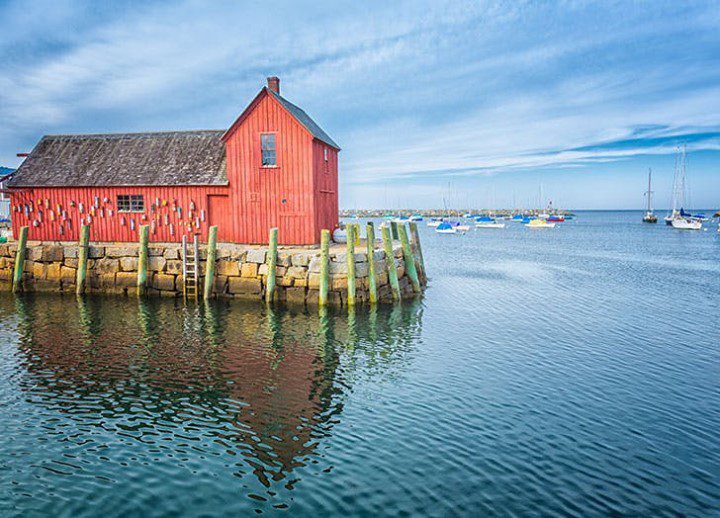By Heather Atwood
Cape Ann in Massachusetts is the quieter cape, the rockier cape, the cape that looks more like Maine than Massachusetts.
Cape Ann is the other cape.
Cape Ann is a quiet, rocky cape, a cape that looks more like Maine than Massachusetts. Its granite cliffs frame intimate little beaches that line its craggy coast. With the exception of Essex, Cape Ann is solid granite. Cape Ann is the other cape.
Cape Cod, the more famous one, has sandy beaches, salt marshes, cranberries, crowds and too many cars. The center of Cape Ann is open space, 3600 acres of woodland called Dogtown.
The 20th century painter Marsden Hartley painted boulder-dotted landscapes there.
For almost 200 years, artists have flocked to Cape Ann, chasing what happens when sunlight reflects off of ocean and rocks. Wealthy Bostonians have ridden the train north to their summer homes in Manchester and Gloucester. Today, day-trippers take the train, discovering, barely an hour’s ride from Boston, the Cape’s quiet beaches, art galleries, lobster rolls and ice cream cones. Here is an overview of the unique charms each of Cape Ann’s four towns holds: Manchester, Essex, Gloucester and Rockport.
Manchester-By-The-Sea:
Manchester-By-The-Sea. You’ve seen the movie? Winner of Academy Awards for Best Actor and Best Screenplay?
Manchester-by-the-Sea, the town — the real town — could win awards too, but in happier categories. Over 150 years ago the wealthy families of Boston claimed it as their favorite summering spot, building grand homes along the coast to match the splendor of their in-town residences. Besides peeking through mature hemlocks along Route 127 for a glimpse of the porte-cochere of Manchester’s mansions, or tracking scenes from the movie, there are some sweet reasons to visit this little town.
A-#1 is Singing Beach — a classic, white sandy cove hugged by granite cliffs — named for the squeaking sound the sand makes beneath one’s feet. Naturalists differ on exactly what causes this environmental situation, but the most common explanation is friction between particularly-sized grains of sand.
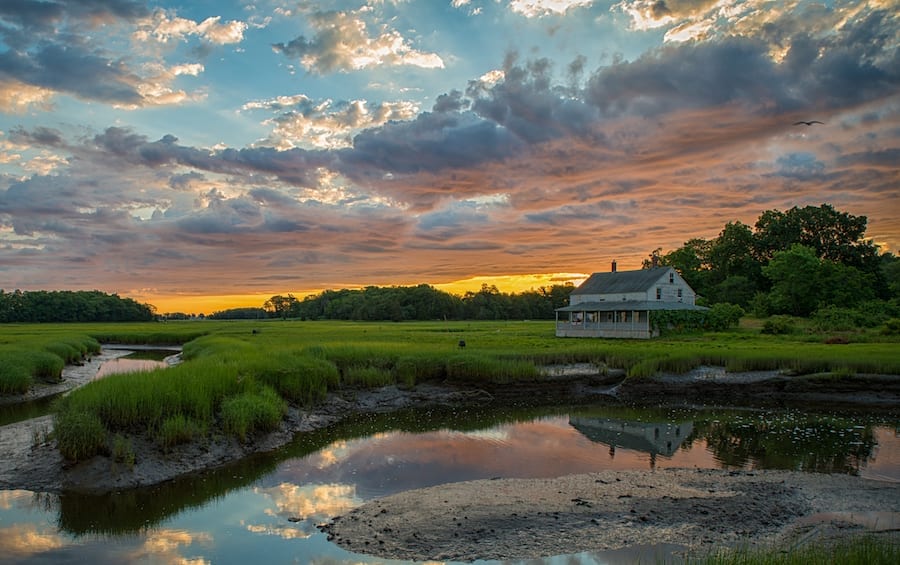
The salt marshes and tidal estuaries of Essex, Massachusetts. (Photo credit: Bridgette Matthews)
Singing Beach is as pretty as it is noisy. A classic, white sandy cove hugged by granite cliffs, the beach is a favorite with day-trippers, many of whom take the train up from Boston, and walk the half-mile from station to waves with their beach towels and picnics.
Whether you’re returning from the beach or simply roaming the North Shore, Manchester has a secret lunch and dinner weapon: five-star fast food. Matthew Gaudet, who once smiled from a Food & Wine cover as one of America’s Top New Chefs, opened Superfine: fast, friendly and delicious. There’s everything from avocado toast to whiskey glazed ribs to burgers to a roasted chickpea and preserved lemon salad. There’s also the juiciest fried chicken – Korean-style – you will ever know. The cocktails mix well with Manchester’s old-time, vintage beachy vibe, too.
Just around the corner from Superfine is The Stock Exchange. To call this purveyor of well-loved household items a consignment shop is to call Harrod’s a grocery store. They say, “One man’s trash is another man’s treasure.” Remember, those grand homes you passed on the way here? The treasures found in the Stock Exchange are a reflection of the discerning tastes of the residents of those Manchester mansions.
Essex:
The 16 square mile village of Essex is best known as the stretch of road edged in antique shops and fried clam shacks. There are magnificent vistas of the winding creek and tidal marshes and two square miles of tidal estuary upon which the autumn light smears itself like butter. In winter, the marsh’s golden, crow-crossed expanse, with the Essex River slipping through like a girl’s lost ribbon, warms the starkest New England day. In spring, a delicate green emerges in the marsh grasses. Crane Beach is just a slip of white sand on the far horizon.
When two-masted schooners ruled the fishing industry, Essex shipwrights launched approximately 4,000 of them — more than any place in the world — skating hundreds of tons of wooden ship down into the Essex River. Today, the Story Family still owns the boatyard and still builds these wooden vessels. Just beside the boatyard, the Essex Ship Building Museum chronicles the history of this once vital industry.
Antiquing and fried-clamming replaced shipbuilding as active verbs in Essex once engines finally defeated schooners as a means of crossing waters. Chubby Woodman started seriously frying clams over one 100 years ago, and his progeny are still at it. Stopping at an Essex clam shack after a day at the beach is one of Cape Ann’s finest traditions. Along with the classic Woodman’s, there is Farnham’s and Essex Seafood Restaurant. We’ll let you do your own survey of which fried clam is best; let’s just say there isn’t a bad one.
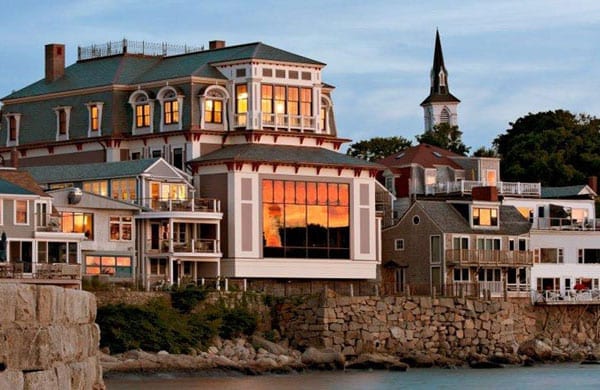
The Shalin Lu Performance Art Center overlooking Rockport Harbor. (Credit: Robert Benson Photography)
Essex is a place where an artist working
en Plein air before one of America’s greatest
views can take a break and pick up a
box of America’s best fried clams.
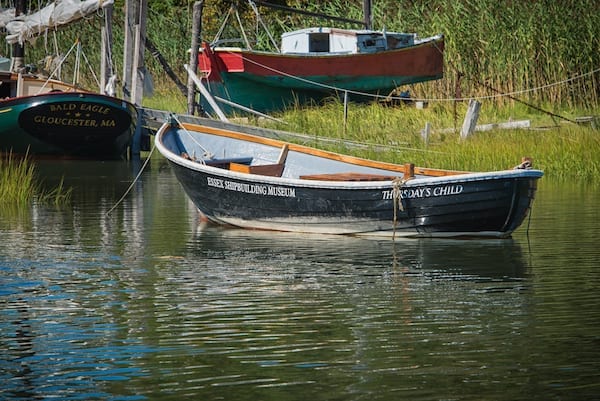
The village of Essex is famous for its handbuilt wooden fishing boats. (Credit: Bridgette Matthews)
Every year in June The Cox Reservation sponsors Art in the Barn, a consuming three-day exhibit of works by artists of these famous Essex vistas. The works are donated, and 50 percent of the sales go to the Greenbelt’s land preservation mission. The Greenbelt saves it, the artists paint it; a symbiotic relationship.
Essex antiquing is a thing. Make sure you visit with an empty trunk. The antique shops appear in between the fried clam shacks, but you do not want to miss the famously artful windows of Andrew Spindler Antiques. As a tastemaker, Spindler blends modern and antique, minimal and baroque, spare and fussy, with visionary talent. He also understands his civic obligation to provide the community with a really good window design as they drive by.
Spindler himself described this tidal town best: “Essex is a place where an artist working en Plein air before one of America’s greatest views can take a break and pick up a box of America’s best fried clams.”
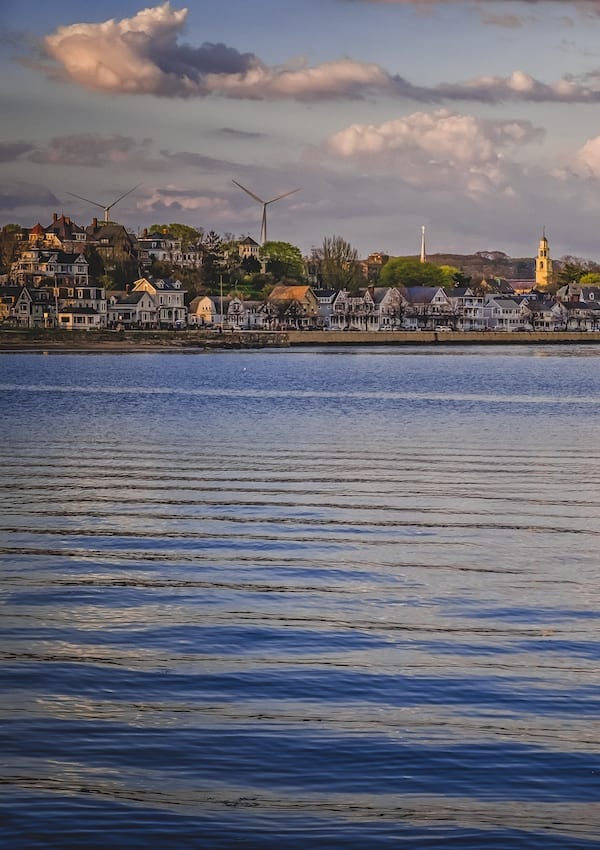
Settled in 1623, Glouchester is America’s oldest fishing port. (Credit: Bridgette Matthews)
Glouchester:
The iconic Gloucester Fisherman statue stands on Gloucester’s Boulevard, facing the mouth of Gloucester Harbor, his hands gripping the ship’s wheel, the sou’wester pushed back from his forehead as if in a stiff wind. In his eyes are storms as legendary as his fish landings.
Behind him rises the city of Gloucester, founded in 1623, where his family — either Sicilian, Portuguese, English or Finn — once waited for a first glimpse of his boat, haloed in squawking seagulls, turning past the Eastern Point breakwater, coming home. At the statue’s back were fish houses, ice houses and fish cutters, all parts of the infrastructure needed to support a fishing fleet of hundreds that headed out to sea for weeks at a time, returning to port loaded with cod, hake or whiting.
The fleet is much smaller now, but shades of those supporting businesses – Cape Pond Ice, Rose Marine, Fisherman’s Wharf – remind a you this is still a fishing town where visitors experience a lively variety of Italian and Portuguese culture, a working waterfront, a frothy local beer, and the best plate of crispy fried haddock on the planet. Where there are fishing boats and seagulls, there are artists and summer homes. Gloucester has those too.
Across the harbor from the city is Eastern Point, which, like Manchester, is home to the grander Gloucester addresses, where 19th-century Boston elites like Isabella Stewart Gardner and Celia Beaux once summered. The Beauport Museum — a National Historic Landmark — is a wonderful Eastern Point visit, giving you a glimpse into the imagination of the home’s original owner, Henry Davis Sleeper, who spun his personal wealth into this revelry of architecture and design: each room is uniquely themed and decorated. One easily images the pleasure Sleeper found entertaining the wealthy Eastern Point summer community in this eclectic harborside estate.
Just as wealthy Bostonians, escaping the city heat, flocked to Eastern Point to enjoy its summer breezes, artists were flocking to a different Gloucester point, Rocky Neck, known also as the Rocky Neck Cultural District. The seaside light refracting off granite and the views of narrow streets and fishermen’s cottages are artists’ gold here. Winslow Homer, Fairfield Porter, and Edward Hopper set up easels here, as artists still do. Rocky Neck retains its whimsical artistic airs and is a great place to pass a summer evening with drinks and dinner at The Studio and then a gallery stroll. Summer theater is a tradition here in the form of Gloucester Stage, a cherished part of the artist community that often premieres works headed to off-Broadway, Broadway, and beyond. There are classics, too, performed by summering professional actors and actresses.
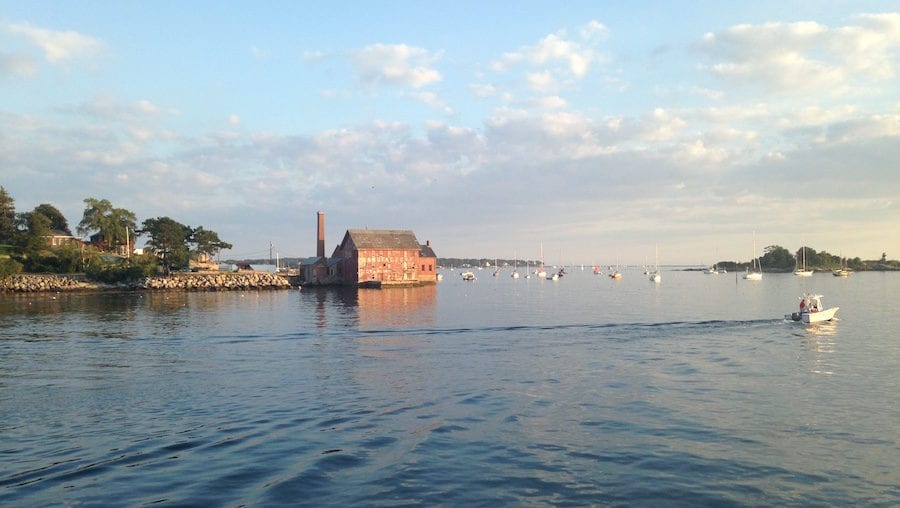
Just down the street from Gloucester Stage is Duckworth’s Bistrot, owned by Ken and Nicole Duckworth. One of the most coveted dinner reservations in town is for a table for two at this intimate restaurant. Ken is a French-trained chef making bistro food with local North Shore ingredients. Nicole makes the desserts. Duckworth’s Bistrot is where Cape Anners go for anniversaries, birthdays, and for any reason at all. Even the seats at the bar are coveted.
The seaside light refracting off
granite, the views of narrow streets
and fishermen’s cottages are
artist’s gold here.
The people who live on Cape Ann trace a regular local food route, stopping first at Alexandra’s Bread, a tin-ceilinged storefront with a baguette that would crack a smile on the iciest Parisian fashion model. Their olive branches studded with meaty black olives, their simple, ciabatta-like cobbles are so delicious that no one gets home without breaking into a warm one.
The next local stop would be Pastaio via Corta — “Pasta on a short street” — for handmade fresh pasta made with artisanal flours. The filled pasta include local cheeses and produce from nearby farms. A little tired and hungry from shopping? Sandpiper Bakery is right around the corner, where owner Susanne Clermont bakes croissants, brioche, and a devilish variety — just too many to choose — of French-style pastries all by hand. It is the perfect breakfast, snack, or lunch pause, with cafe tables and dark roast coffee.
The Harbor Walk traces the inside of Gloucester Harbor, passing busy restaurants and fish landings. At the far eastern end of the walk stands the new Beauport Hotel. With a modern cottage-style seaside design, the Beauport feels like a fresh, uptown way to meet friends for cocktails on the water. The wide plank deck overlooks Pavillion Beach. There are fireplaces to sit around if the air gets chilly. It’s an elegant stay, with a rooftop pool, the place in Gloucester where you get the lobster roll, the vodka tonic, and the view, but maybe you wear heels.
On the last weekend in June, the view from the Beauport Hotel deck is the best seat in the city for Gloucester’s most famous athletic event: The Greasy Pole. The entire city crowds onto Pavillion Beach, or one of the myriad boats that cover the water to watch young Italian men attempt to walk a pole extending horizontally from a four stories-high (depending on the tide) platform about 200 feet offshore. Slathered in grease, oil, and fish trimmings, the pole is the “rite of passage” testing the manhood of the sons of every Italian Gloucester fishing family. The goal is to make it the length, grab the flag at the end of the pole, fall to the sea gripping it, and spend the rest of the year a champion. Most just fall; some are hurt; and some break ribs. The Greasy Pole is just part of St. Peter’s Fiesta, the city’s five-day bargain with St. Peter, protector of fisherman.
In Gloucester, following years of tradition, Italian families still build altars in their living rooms where they say novenas for nine evenings before each saint’s day. They celebrate St. Anthony and St. Joseph, visiting each other’s homes and feasting on the last day. But the most celebrated saint is Peter, the fisherman.
Every year, St. Peter’s Fiesta becomes a marathon of culture, athletics, religion, not-so-scary carnival rides, and Italian ice as the Italian-American fishing community preserves the traditions their great-grandparents brought with them when they arrived in this city 100 years ago. St. Peter’s Fiesta symbolizes the path their lives have taken. A wooden statue of the saint is paraded through the streets of Gloucester. Young children proudly walk bearing wooden oars representing the fishing vessels of lost relatives. The priest arrives to bless the fleet. Back at Pavillion Beach, young men race Seine boats, the large wooden dories once used to drag fishing nets off schooners on George’s Banks. The symbolism is heavier here than it used to be because Gloucester’s commercial fishing fleet is a fraction of what it once was, but Gloucester fishing families still revel in these traditions.
At the Cape Ann Museum, you can see that artists — many of them internationally known — have been drawn to Cape Ann for centuries. The museum has the largest collection of the 19th-century artist Fitz Henry Lane, who painted Gloucester Harbor the way Canaletto painted Venice. Also on exhibit are works by internationally famous sculptors Paul Manship, Walker Hancock, and George Demetrious, who lived within a half-mile of each other in the northern woods of Gloucester.
At the far northern end of Rogers Street, The Crow’s Nest, the fisherman’s bar George Clooney made famous in “The Perfect Storm,” still serves a better than average burger. The bartenders speak fishing fluently, but they are also happy to talk with tourists about Gloucester’s Hollywood moment and the storm that created it. The Crow’s Nest doesn’t clean itself up too much for tourists, but that’s the authentic part.
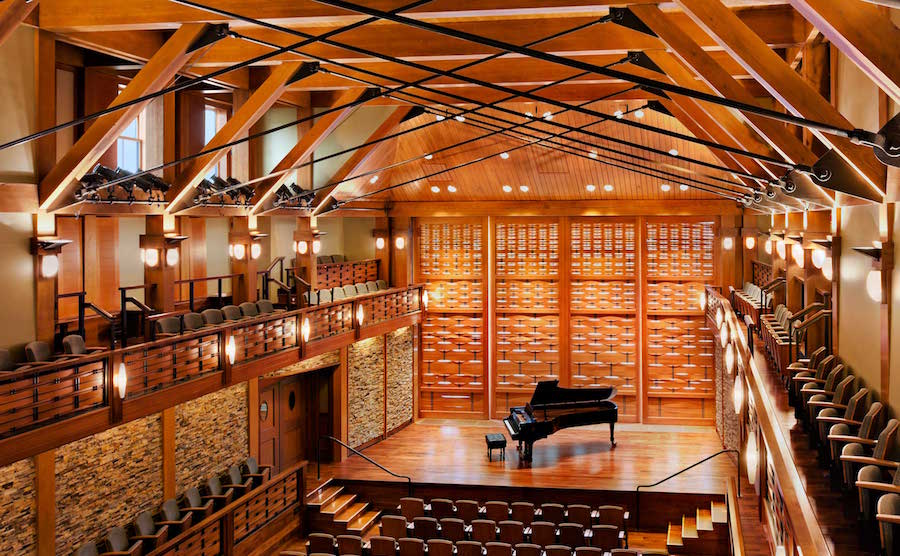
Rockport:
Quaint architecture, quiet beaches, scenic vistas, quarries, lobstering, and a world-class concert hall are the currency Rockport trades in from its place at the tip of Cape Ann.
You can’t beat the views: from the wild, Moorish peak of Halibut Point State Park which looks north to Maine to a drive down Eden Road for the breathtaking sights of Thacher Island, where the Twin Lighthouses pulse through inky nights and foggy days.
Temperance in Rockport has been official ever since 1856, when an angry Rockport wife, Hannah Jumper, gathered together 100 housewife friends, fed up with their husbands’ and sons’ tippling, and marched down Main Street, swinging hatchets, destroying rum barrels all over town. “The gutters ran with rum,” it is said of that night. Rockport, it’s innocence preserved, remained dry until about ten years ago.
Today, wine, beer, and even a martini can be enjoyed with your lobster roll. Since those Hannah Jumper days, the town has been gifted with the Shalin Liu Concert Hall, which blends into the Victorian buildings on Main Street. Inside is one of the country’s most acoustically perfect stages, where internationally acclaimed classical, popular, and jazz artists perform. The concert hall is understandably intimate; there isn’t a bad seat in the house, but the building’s crowning feature is the stage: the entire rear wall of the stage is not a wall at all, but an enormous two-story glass window offering up the light bouncing off bobbing lobster pots and boats in Rockport Harbor to the music of a Beethoven violin sonata. Or an evening of Carmen. Or Roseanne Cash.
In Rockport, they swim in holes, quarries to be exact. The woods are speckled with these remains of the granite industry, and local kids know all the places to go. But they also dance in the quarries; Windhover Center for the Performing Arts in Rockport has established a summer tradition of quarry dances. For two weeks during the summer, the Dusan Tyneck Dance Theater from New York City visits and choreographs a dance around a quarry. Each year it’s a new quarry and a new dance. Nature, humans, air and water merge into one celebration of movement.
Bearskin Neck, a narrow street lined with old fish shacks-turned-shops, needs only an ice cream cone in hand to enjoy. Feather & Wedge offers a fine glass of wine, and Roy Moore Lobster on Bearskin Neck offers anything on the half shell and a cracked lobster dripping in butter in that classic paper boat, but Cape Hedge Beach — at the far southern end of Rockport — is still one of the best places for a Rockport meal. Nicoise on a baguette in the beach chair at lunch is as good as it gets. Or stay past sunset, pull out the sweatshirts, and drag up some driftwood to build a fire. That’s when some of Rockport’s finest cooks show their stuff , under the shooting stars, their toes in the cold sand, cheered on by their sun-weary friends.
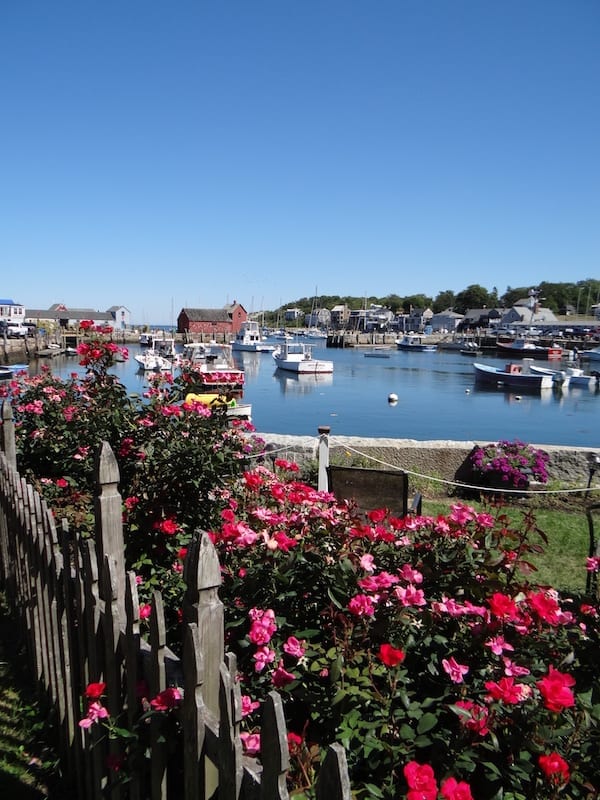
Maybe it’s the window boxes on Main Street fl uttering with seasonal flowers, maybe it’s the smell of fresh homemade donuts rising from The Brothers Brew, maybe it’s the years and years of children’s sand buckets on Front Beach, but, Mrs. Jumper, innocence in Rockport is still winning.

